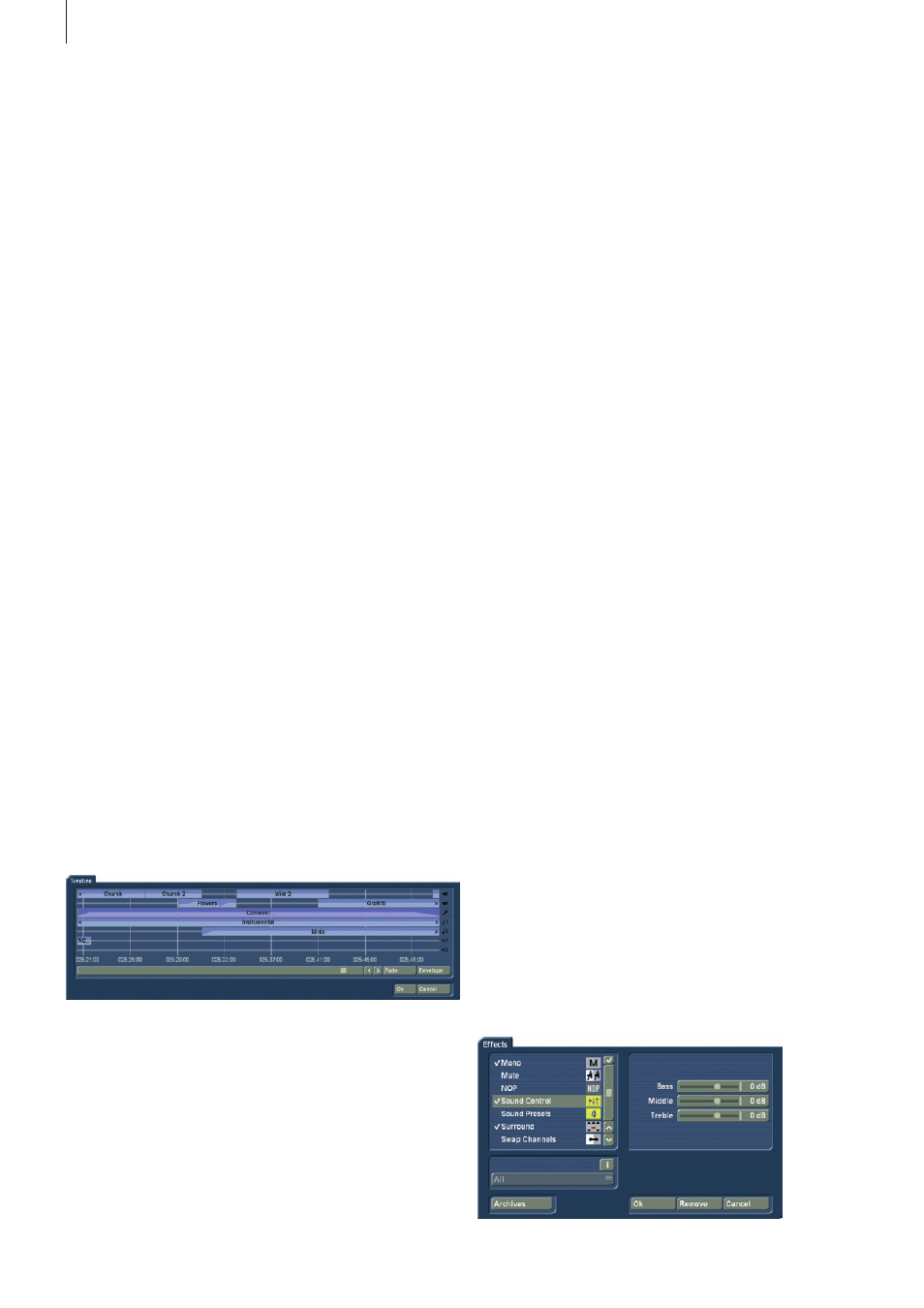MacroSystem Bogart SE Ver.2 User manual User Manual
Page 62

60 Chapter 4
(8) Hit the Remove button to delete the active audio sample .
This function has no effect upon the original track, as only
audio samples from the supplementary tracks can be deleted .
Remember that removing a audio sample may necessitate
recreation .
(9) Clicking on "Replace" opens the list of sound clips and you
can select a clip that now replaces the previously active clip on
the soundtrack .
Especially when you have already individually positioned a
sample, it is an advantage to replace, placing the new sample
at the exact same position .
(10) The Range function is used for adjusting the position and
the IN and OUT points of a audio sample . The Range button
can be selected when an audio sample is clicked upon and
thus activated . A Trim menu is called up similar to that for the
trimming of video scenes . Once you have selected Position,
you can move the entire audio sample with the aid of the Start
button . Should the audio sample be too long, you can also
shorten it at the beginning and end . Select the Trim function
and then the IN and OUT buttons in this case . The sound
characteristic is displayed by the wave form (Chapter 3 .3) . Play
back again to check any changes . The new position is also
shown graphically when you return to the Audio-Mix menu .
(11) Bogart SE is able to play back several audio tracks simul-
taneously only if they have first been created (if necessary by
clicking on Create) . Portions which have not been created are
displayed by yellow regions in the color control bar at the top .
The entire audio visible in the active image size is generally
created together with the active audio sample (highlighted in
blue), even if it lies outside the window . If the entire storyboard
is to be created, launch creation from the Finish menu .
(12) Click on the Timeline button to call up a new window in
which the active audio sample is displayed in full and which
shows the other samples in relation to it .
The active audio sample thus serves as the dimension for the
full width of the new window . This permits a larger (full-screen)
display of very short audio samples (which would otherwise
appear only as a narrow line in the storyboard), whereas the
full length of very long audio samples (which would otherwise
run over the limits of the visible region in the storyboard) is
displayed with all audio samples of adjacent sound tracks . The
timeline thus offers a scaled view by which, for example, the
volume characteristic or any fades can be viewed more easily .
This window displaying the time data serves mainly to pro-
vide a better overview . You can however also use it to move
the displayed part below the timeline display with the aid of
the scrollbar, to change the sound track to a different audio
sample by clicking on it, and to call up the functions Fade and
Envelop from the timeline display .
The symbols >> and << indicate that the audio sample does
not end at the edge of the timeline, but continues .
The original sound track is displayed twice, one display above
the other . The reason is as follows: if for example you have
inserted a transition effect, two audio samples overlap . In the
timeline display, these two audio samples are then displayed in
two lines (in both original sound tracks) .
(13) Click on the Fade button to call up a dialog in which you
can adjust fade-in and fade-out of the currently active au-
dio sample . The audio volume is consequently reduced or
increased for the selected duration (which of course cannot
exceed the length of the audio sample), reaching the selected
baseline volume at the end of fading .
You also will find the control "Audio Settings" in “Project
Settings”, with which you can specify whether the audio fade
should be “constant” or “lowered” .
Certain practical time values for fading in and out are already
provided as defaults . Should you therefore wish to fade a com-
mentary in softly, you can for example select a fade-in time of 1
second (1 s), and thereby prevent the sound from being clipped .
Should you wish to fade out an audio sample, the volume is
gently reduced towards the end of the sample and is com-
pletely silent at the end of fading .
The fade-in and fade-out times act upon all selected changes,
i .e . including any changes to volume of the adjacent tracks .
For example, as the commentary volume is being increased,
the background music is gently reduced to the selected value .
The volume characteristic is displayed clearly in the audio
samples . If you then trim a sample or move it, the fade in and
fade out times remain .
(14) The Effects button calls up the Audio Effects menu . Audio
effects can be applied to either a single audio sample or a
complete sound track .